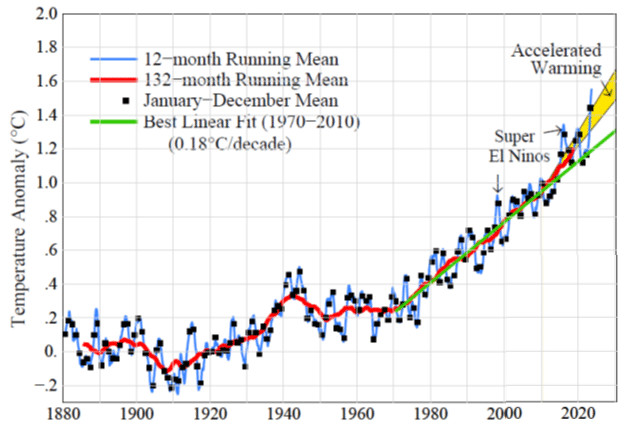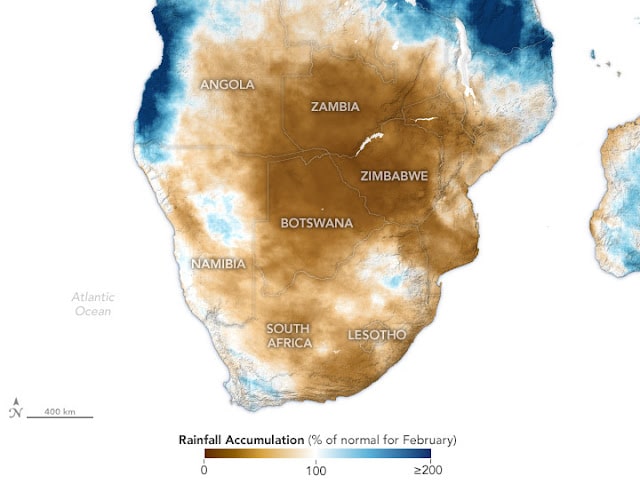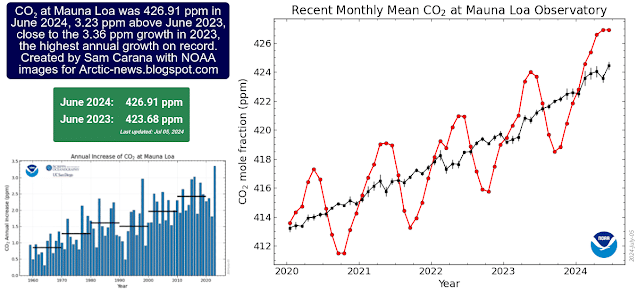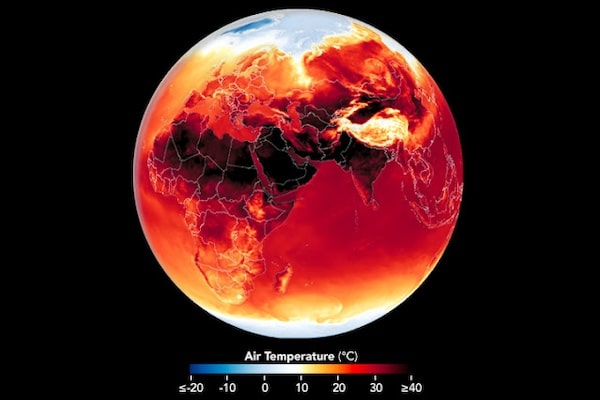As temperatures in large parts of the Earth are soaring (cf. 52.3°C in Delhi, flames engulf large regions in California, tornadoes ravage the Gulf of Mexico states, severe drought starve populations in southern Africa and climate extremes continue to taking over large parts of the Earth. Much like oncologists advising patients and their families of a terminal illness, so do climate scientists agonizing while reporting the advent of dangerous warming as temperatures rise and tipping points are broken. But while climate change has become more than evident, there is a heavy price to be paid by those who try to alert the public.

Figure 2. Global temperature relative to 1880-1920 based on the GISS analysis (Hansen et al., 2024).
One of the glaring misconceptions, which ignores the dispersal of greenhouse gases throughout the atmosphere, is as if their global effects depend on the country from which the carbon is extracted. Further, politically originated stigmas labels scientists as some kind of “alarmists” or “Cassandras”. A threat of institutional penalties affects scientist’s jobs. Along with the dominion of vested pro-carbon interests these factors drive humanity blind toward the Sixth Mass Extinction of Species.

Figure 3. A prolonged dry spell in southern Africa in early 2024 scorched crops and threatened food security for millions of people.
A number of prominent climate scientists representing the scientific consensus on climate change, as documented by the IPCC, have tried their best to convey the message in public forums, but were mostly shunned by conservative media. At the same time many climate scientists tend to regard the IPCC-based climate consensus as too optimistic. An article titled When the End of Human Civilization Is Your Day Job (Richardson, 2015) states …
Among many climate scientists, gloom has set in. Things are worse than we think, but they can’t really talk about it… Climate scientists have been so distracted and intimidated by the relentless campaign against them that they tend to avoid any statements that might get them labelled “alarmists”, instead retreating into a world of charts and data.
It’s interesting that these public climate debates leave out almost entirely a third part of the debate, namely a very substantial number of scientists, competent scientists, who think that the scientific consensus is much too optimistic. A group of scientists at MIT came out with a report about a year ago describing what they called the most comprehensive modelling of the climate that had ever been done. Their conclusion, which was unreported in public media as far as I know, was that the major scientific consensus of the international commission is just way off, it’s much too optimistic… their own conclusion was that unless we terminate use of fossil fuels almost immediately, it’s finished. We’ll never be able to overcome the consequences. That’s avoided in the debate.
Antarctica is losing ice at an average rate of more than 150 billion tons per year, and Greenland is losing more than 270 billion tons per year, adding to sea level rise. Some glaciologists and Arctic scientists consider the accelerated rate of glacial melt in Greenland and West Antarctica may result in little remaining ice over these terrains toward the end of the century, leading to sea level rise on the scale of many meters, with catastrophic consequences for coastal and river valley population centres.
The Arctic Ocean contains vast amounts of carbon accumulated during the Pleistocene ice ages. The greenhouse effect of methane traps up to 100 times more heat in the atmosphere than carbon dioxide within a 5 year period, and 72 times more within a 20 year period. Atmospheric levels of greenhouse gases—carbon dioxide, methane, and nitrous oxide—continued their climb during 2023 according to the latest measurements from NOAA and CIRES scientists. The current CO₂ growth rate threatens an irreversible shift in the state of the Earth climate through looming tipping points, including transient cooling events induced by flow of cold ice melt water into the oceans from Greenland and Antarctica; Glikson (2019).

Figure 4. Carbon dioxide at Mauna Loa, Hawaii.
There is little evidence that climate science had much of an effect on the outcome of the Paris Agreement. The warming target of +1.5°C has already been breached over the continents or is masked by the reflective albedo of transient sulphur aerosols. At the current growth rate of ~3 ppm/year CO₂ will rise closer to the stability threshold of the polar ice sheets.
Little encouragement can be gained from the non-binding promises emerging from climate conferences, which James Hansen described as a “fraud”.
While the implications of the global climate emergency have reached the defence establishment, the world continues to spend near to $2.4 trillion each year on the military instead on the protection of life.
As the portents for a major mass extinction of species are rising—who will defend life on Earth?
A/Prof. Andrew Y Glikson Earth and climate scientist

